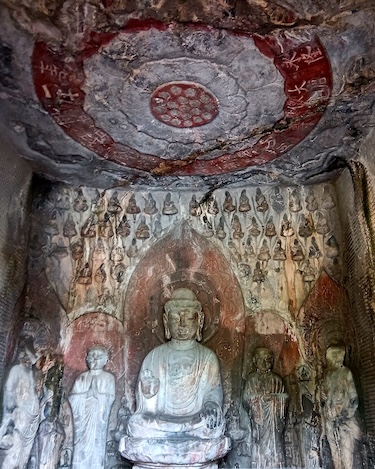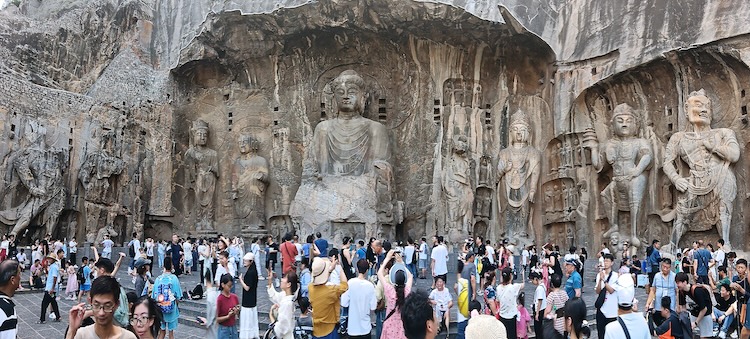A Lotus News Feature by Kalinga Seneviratne
LUOYANG, China | 15 August 2024 (IDN | LCN) — Though people around the world may not relate China with Buddhism these days, the reality is that Buddhism has been an integral part of Chinese civilization and culture for 1900 years, and even today with over 200 million followers, China has the world’s largest Buddhist population.
Both these facts are evident today at Luoyang in Henan Province in Central China. The UNESCO World Heritage listed Longmen Caves—a series of Chinese Buddhist Cave Temples dating back to the 5th century—carved into a rock over a kilometer long along the banks of the Yishui River is located about 12 km south of the city.

The White Horse Temple—a Buddhist monastery built in the 1st century—is located about 20 km from the city and it is still occupied by Buddhist monks and people go in their thousands to worship there.
Luoyang the capital of nine dynasties starting from around 770 BCE is located in the middle reaches of the Yellow River in the western part of Henan Province. Though it is an industrial city today, the Chinese government has paid special attention to the protection of Luoyang as a historic city reflecting the Buddhist heritage of China that draws millions of local and foreign tourists.
Canadian born Edmund Wai Man Lai, a Phd student in China, who was visiting Luoyang for the first time, told IDN that he has a “very ingrained sentiment towards Buddhism as part of Chinese culture”. He would like Luoyang to be part of a modern Buddhist pilgrimage circuit linking to the new Silk Route project. “It only makes sense to remind those in the present of the significance of this historic city”, he added.
During the Spring festival this year, Luoyang attracted more than 11 million visitors, with China’s Global Times reporting that about 75 percent of the visitors were young people born after 1980 and 1990, with the Buddhist sites in the city providing them an experience that “combines the sacred sentiments of Buddhism (and) a glimpse into China in the vibrant Tang Dynasty”.
The White Horse Temple—known in Chinese as Baima Si—was built in 68 CE during the Eastern Han Dynasty under the patronage of Emperor Ming. It is the first Buddhist temple to be built in China after Buddhism was introduced to the country. Thus it is referred to as the “Cradle of Buddhism” in China.
The name “White Horse” is derived from the historic records of the emperor sending Chinese monks to India to obtain Buddhist scriptures and them bringing it back riding white horses.
Thirteen dynasties have established their capital in Luoyang, and this city is also the eastern starting point of the ancient Silk Route, which not only traded in goods but also resulted in Buddhism spreading out across Asia from India and later from China. Thus, as post-doctoral researcher Kai Shmushko notes promoting Luoyang as a leading Buddhist tourism site helps China’s soft power potential as the Silk Route was also known as the “Buddhist Road” and it will help President Xi Jinping’s flagship Belt and Road Initiative (BRI).
There are three new Buddhist temples built in the 21st century adjoining the White Horse Temple reflecting the Thai, Myanmar and Indian Buddhist architecture. Built with the support of the governments of these countries, Shmushko argued that it “symbolizes the cultural collaborations of these countries” in the 21st century, which will indirectly promote the BRI concepts as the modern route for pan Asian cultural connectivity.
When I visited the temples on a Sunday during the July school holiday period, it was crowded with thousands of Chinese with young families, and youth. They were not mere tourists; many have purchased joss ticks from the stalls outside for offering at the temples with traditional Buddhist prayers.

“Buddhism is part of Chinese traditional culture,” argues Neng En, a senior monk at the 300-year-old Gui Yuan Temple in Wuhan. “It is important for Buddhism to connect with different people to inspire modern generations and (through BRI) Buddhism should help people to be friendly to each other.”
At Longmen Grottoes (Caves) there were thousands of tourists – not necessarily worshippers—though some did pay the traditional respect to the Buddha statues. These are among the greatest treasure troves of ancient stone carving in China, which represents the flowering of the art of stone carving and the development of Buddhism in China. The caves were listed as an UNESCO World Heritage Site in 2000.
As most of the statues were carved into the cliff face, they had long been exposed to the heat of the sun, rain erosion and atmospheric pollution, causing the rock to crumble and break off in chunks. In November 2001, under UNESCO sponsorship, Japanese experts trained the Chinese on repair and restoration work of the rock carvings. The project is hailed as a good example of international cooperation.
Longmen Grottoes, at first sight, would remind one of the Ajantha Buddhist Caves in India, another UNESCO World Heritage Site. While many of Ajantha’s cave paintings have been touched up and are back to its colourful glory, at Longmen it is mainly the Buddhist carvings (statues) that are dominant with glimpses of colours on the rocks behind the statues visible of bygone rock arts.
In the 1 km long stretch of cliffs, there are caves of varying sizes all of which have been carved with Buddha images and his associates, and the devas (gods). It is estimated that there are over 97,000 Buddhist statues with the tallest standing at 17.14 meters and the smallest at just 2 centimeters.
It is believed that carving of the Buddha statues on the cliffs started in 493 CE after Emperor Xiaowen relocated the capital to Luoyang. While the first 35 years have been the blooming period of building the Longmen Grottoes, it has however continued for the next 500 years—as Buddhism spread in China.

The Vairocana Buddha is the tallest of all statues in the Longmen Grottoes. The head is four meters high, with a plump round face and crescent moon-shaped eyebrows above amiable, heavy-lidded eyes with a subtle smile signifying inner peace and tranquillity.
Binyang Cave is one of the largest and most impressive and its believed to have been built during the Northern Wei Dynasty. The construction has lasted 24 years, utilizing 2.8 million laborers.
The rock carvings hint at a great degree of cultural fusion between the Indian and Chinese civilizations at the time. [IDN-InDepthNews]
Photo: The one km long Longmen Caves, resembling the Ajantha Caves of India, with Yishui River in the foreground. Credit: Kalinga Seneviratne


